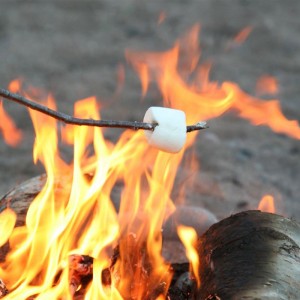Marshmallow sticks and medicine trees

A tasty summer pastime. Photo: Nina Hale, Creative Commons, some rights reserved
I don’t know about you, but I really look forward to those sticky summer evenings around a campfire. Not the sweltering kind of sticky, mind you. I’m thinking of the smoke-dodging, s’more-making nights spent with family and friends, wishing for fewer mosquitoes and more wet-wipes. Proper marshmallow toasting requires a high tolerance for concentrated sugars, plus a good stick. Marshmallows and a fire are helpful, too.
Last year someone asked me what kind of tree yields the best marshmallow stick. It seemed obvious since the technical process for locating the right stick historically involved two criteria: It must be 1) close at hand, and 2) long enough to avoid burning oneself. However, it occurred to me if it’s a fresh-cut live branch, the species of tree is important.
Wild (black) cherry has tasty pea-size fruit, but its inner bark and leaves contain cyanogenic glycosides that are converted to cyanide in the body. These compounds are destroyed when heated to the boiling point, which is why many animals have been poisoned from consuming black cherry leaves and twigs: they neglected to cook them. Although the amount of cyanogenic glycosides in the tip of a black cherry branch is probably tiny, it’s something to consider.
Yellow and black birch trees produce methyl salicylate, or wintergreen oil. Not only is a birch branch safe to use, it’s delicious. Birch twigs were once the source of commercial candy flavoring, so you’ll get a marshmallow with a slight wintergreen zest. Then you can cut a fresh birch twig and chew the end a bit to make yourself a traditional camp toothbrush, flavoring included.
Willow branches contain salicin, which our bodies convert to acetylsalicylic acid, or aspirin. Willow has been used for pain relief for thousands of years. Our native black willows, the ones that grow very large on stream banks, have the highest salicin content of any willow. Cut a black willow stick, take two marshmallows, and call me in the morning.
Witch hazel bark is an effective astringent, which means it constricts body tissues. Its leaves and bark are still used to make various over-the-counter products to relieve eczema, hemorrhoids, and other ailments. Using this type of branch is perfectly harmless, but unless you need help puckering up, don’t eat the witch hazel marshmallows.
Many of our native viburnums such as wild raisin and arrowwood give off volatile chemicals called butyrates after they’re cut, compounds which smell akin to dirty socks. I don’t know how long it takes a fresh-cut viburnum branch to smell rank—feel free to experiment, preferably downwind from your friends.
Buckthorn is an invasive understory tree with glossy leaves and dark purple to black berries. As its name implies, it has thorn-like twig spurs, so you’re not likely to choose a buckthorn branch in the first place. But they grow just about everywhere, so watch out. They’re not deadly but they’re not good for you. A buckthorn marshmallow could leave you guarding the outhouse all night.
Our native hawthorn, on the other hand, is OK to use. An ambitious (and very cautious) camper probably could impale and roast half a dozen marshmallows on the long slender thorns of a single hawthorn branch.
The resin in pine, spruce, and cedar branches is nontoxic, but they are seldom used for roasting. No sense getting sticky before the marshmallows go on, right? Dogwood, ash, maple, and elm make good marshmallow sticks; safe but without any smells or whistles. But then, maybe given some of the choices you’ll want to stick with boring.
For help with tree identification go to http://bhort.bh.cornell.edu/tree/trees.htm or call your local Extension office.
Paul Hetzler is a horticulture and natural resources educator with Cornell Cooperative Extension of St. Lawrence County.
Tags: health, outdoor recreation, trees








I live on the Gulf Coast. Many years ago my daughter brought a small tree from a Nursery in Houston and planted it in my flower bed. It is a slow growing tree but quite beautiful. Until today I was not able to identify it. The tree is a Mountain Maple. This tree is not found in this tropical climate. I cannot find information about the tree. Could you provide the information of diseases, etc. for me? I do want to keep it. Thank you.